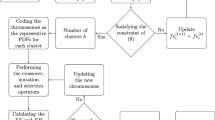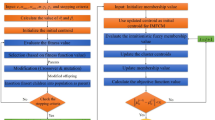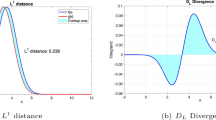Abstract
Based on the genetic algorithm, this study develops the new fuzzy clustering method for probability density functions (pdfs) with the important improvements. First, the \(L^1\)-distance is proposed as the measure to evaluate the level similar of the pdfs. It is surveyed to find the bounds and established the methods to compute. Second, we propose the new objective for the genetic algorithm. This objective measures both the similarity of elements in each group and the quality of clustering. Finally, the operators such as crossover, mutation, and selection of the traditional genetic algorithm are improved. Combining these improvements, we have an efficient cluster analysis algorithm for pdfs. In this algorithm, the proper number of groups, the specific pdfs in each cluster, and the fuzzy relationship between the pdf to the established clusters are determined at the same time. The convergence of the proposed algorithm is proved by theory and performed by the established MATLAB program. The experiments and applications show superiority of the developed algorithm in comparing to the existing algorithms. The proposed algorithm is also applied in recognizing images to certify the feasibility and applicability of the studied problem.















Similar content being viewed by others
References
Hubert L, Arabie P (1985) Comparing partitions. J Classif 2(1):193–218
Nguyentrang T, Vovan T (2017) Fuzzy clustering of probability density functions. J Appl Stat 44(4):583–601
Cabanes G, Bennani Y, Destenay R, Hardy A (2013) A new topological clustering algorithm for interval data. Pattern Recognit 46(11):3030–3039
Chen J-H, Hung W-L (2015) An automatic clustering algorithm for probability density functions. J Stat Comput Simul 85(15):3047–3063
Goh A, Vidal R (2008) Clustering and dimensionality reduction on Riemannian manifolds. In: 2008 IEEE conference on computer vision and pattern recognition. IEEE, pp 1–7
VoVan T, NguyenTrang T (2018) Similar coefficient for cluster of probability density functions. Commun Stat Theory Methods 47(8):1792–1811
VoVan T, Trang TN (2018) Similar coefficient of cluster for discrete elements. Sankhya B 80(1):19–36
Bezdek JC (1980) A convergence theorem for the fuzzy isodata clustering algorithms. IEEE Trans Pattern Anal Mach Intell 1:1–8
Bora DJ, Gupta AK (2014) Impact of exponent parameter value for the partition matrix on the performance of fuzzy c means algorithm. arXiv preprint arXiv:1406.4007
Jain M, Vayada MG (2017) Non-cognitive color and texture based image segmentation amalgamation with evidence theory of crop images. In: 2017 third international conference on sensing, signal processing and security (ICSSS). IEEE, pp 160–165
Vovan T, Nguyen-Thoi T, Vo-Duy T, Ho-Huu V, Nguyen-Trang T (2017) Modified genetic algorithm-based clustering for probability density functions. J Stat Comput Simul 87(10):1964–1979
Vovan T (2017) L 1-distance and classification problem by Bayesian method. J Appl Stat 44(3):385–401
Phamtoan D, Vovan T, Pham-Chau A, Nguyen-Trang T, Ho-Kieu D (2019) A new binary adaptive elitist differential evolution based automatic k-medoids clustering for probability density functions. Math Probl Eng 2019:4528
Montanari A, Calò DG (2013) Model-based clustering of probability density functions. Adv Data Anal Classif 7(3):301–319
Matusita K (1967) On the notion of affinity of several distributions and some of its applications. Ann Inst Stat Math 19(1):181
Pham-Gia T, Turkkan N, Vovan T (2008) The maximum function in statistical discrimination analysis. Commun Stat Simul Comput 37:320–336
Glick N (1973) Separation and probability of correct classification among two or more distributions. Ann Inst Stat Math 25(1):373–382
Vovan T, Pham-Gia T (2010) Clustering probability distributions. J Appl Stat 37(11):1891–1910
Vovan T, Phamtoan D, Tranthituy D (2019) Automatic genetic algorithm in clustering for discrete elements. Commun Stat Simul Comput 56:1–16
Holland JH (1973) Genetic algorithms and the optimal allocation of trials. SIAM J Comput 2(2):88–105
Bandyopadhyay S, Maulik U (2001) Nonparametric genetic clustering: comparison of validity indices. IEEE Trans Syst Man Cybern C 31(1):120–125
Bandyopadhyay S, Maulik U (2002) Genetic clustering for automatic evolution of clusters and application to image classification. Pattern Recognit 35(6):1197–1208
Vovan T (2019) Cluster width of probability density functions. Intell Data Anal 23(2):385–405
Lai C-C (2005) A novel clustering approach using hierarchical genetic algorithms. Intell Autom Soft Comput 11(3):143–153
Kamel MS, Selim SZ (1994) New algorithms for solving the fuzzy clustering problem. Pattern Recognit 27(3):421–428
Bazaraa MS, Sherali HD (2013) Shetty CM nonlinear programming: theory and algorithms. Wiley, New York
Golilarz NA, Demirel H, Gao H (2019) Adaptive generalized gaussian distribution oriented thresholding function for image de-noising. Int J Adv Comput Sci Appl 10(2):10–15
Deep K, Singh KP, Kansal ML, Mohan C (2009) A real coded genetic algorithm for solving integer and mixed integer optimization problems. Appl Math Comput 212(2):505–518
Diem HK, Trung VD, Trung NT, Vovan T, Thao NT (2018) A differential evolution-based clustering for probability density functions. IEEE Access 6:41325–41336
Xu X, Li X, Liu X, Shen H, Shi Q (2016) Multimodal registration of remotely sensed images based on Jeffrey’s divergence. ISPRS J Photogramm Remote Sens 122:97–115
Grogan M, Dahyot R (2019) L2 divergence for robust colour transfer. Comput Vis Image Underst 181:39–49
Acknowledgements
This research is funded by Ministry of Education and Training in Viet Nam under Grant Number: B2022-TCT–03.
Author information
Authors and Affiliations
Corresponding author
Ethics declarations
Conflict of interest
The authors declare that they have no conflict of interest.
Additional information
Publisher's Note
Springer Nature remains neutral with regard to jurisdictional claims in published maps and institutional affiliations.
Appendix
Rights and permissions
About this article
Cite this article
Phamtoan, D., Vovan, T. Automatic fuzzy clustering for probability density functions using the genetic algorithm. Neural Comput & Applic 34, 14609–14625 (2022). https://doi.org/10.1007/s00521-022-07265-7
Received:
Accepted:
Published:
Issue Date:
DOI: https://doi.org/10.1007/s00521-022-07265-7






